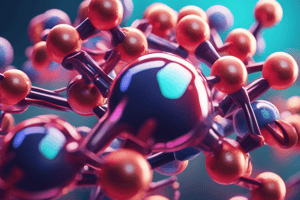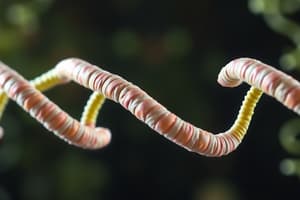Podcast
Questions and Answers
What is the primary function of proteins in cells?
What is the primary function of proteins in cells?
- Forming cell membranes
- Carrying out a variety of functions (correct)
- Transmitting signals between cells
- Storing genetic information
All amino acids are uncharged and nonpolar.
All amino acids are uncharged and nonpolar.
False (B)
What is the start codon that specifies the beginning of protein synthesis?
What is the start codon that specifies the beginning of protein synthesis?
AUG
Proteins are made up of a sequence of __________.
Proteins are made up of a sequence of __________.
Match the amino acid with its property:
Match the amino acid with its property:
What is the role of tRNA in protein synthesis?
What is the role of tRNA in protein synthesis?
There are 64 possible codons, and some codons do not specify an amino acid.
There are 64 possible codons, and some codons do not specify an amino acid.
What type of reaction links amino acids together to form proteins?
What type of reaction links amino acids together to form proteins?
Which of the following correctly describes the role of rRNA in forming a peptide bond?
Which of the following correctly describes the role of rRNA in forming a peptide bond?
The primary structure of a protein refers to its three-dimensional shape.
The primary structure of a protein refers to its three-dimensional shape.
What is the secondary structure in proteins commonly characterized by?
What is the secondary structure in proteins commonly characterized by?
In proteins, hydrophobic regions are typically found on the ______.
In proteins, hydrophobic regions are typically found on the ______.
Match the following protein structures with their definitions:
Match the following protein structures with their definitions:
Which types of non-covalent interactions are involved in protein folding?
Which types of non-covalent interactions are involved in protein folding?
Proteins can fold into any conformation regardless of their amino acid sequence.
Proteins can fold into any conformation regardless of their amino acid sequence.
What is the common turning rate of an α-helix?
What is the common turning rate of an α-helix?
Flashcards
Protein Function
Protein Function
Proteins carry out a wide range of functions in cells, including catalysis, structural support, and transport.
Amino Acid Structure
Amino Acid Structure
Each amino acid has an amino group, a central carbon (alpha carbon) with an attached R-group, and a carbonyl group.
R-Group Types
R-Group Types
R-groups determine amino acid properties: acidic (negative charge), basic (positive charge), polar (uneven charge), or nonpolar.
Peptide Bond Formation
Peptide Bond Formation
Signup and view all the flashcards
Codon
Codon
Signup and view all the flashcards
Start Codon
Start Codon
Signup and view all the flashcards
Stop Codon
Stop Codon
Signup and view all the flashcards
tRNA Adaptor
tRNA Adaptor
Signup and view all the flashcards
Ribosome Translocation
Ribosome Translocation
Signup and view all the flashcards
Protein Structure Levels
Protein Structure Levels
Signup and view all the flashcards
Protein Folding
Protein Folding
Signup and view all the flashcards
Non-Covalent Interactions in Folding
Non-Covalent Interactions in Folding
Signup and view all the flashcards
α-Helix
α-Helix
Signup and view all the flashcards
β-Sheet
β-Sheet
Signup and view all the flashcards
Protein Structure Visualization
Protein Structure Visualization
Signup and view all the flashcards
Study Notes
Protein Structure and Function
- Proteins are crucial for numerous cellular functions, including catalysis, structural support, and transport.
- Proteins are composed of amino acid sequences, each with a unique side chain.
- Twenty different amino acids form various R-groups (acidic, basic, polar, nonpolar)
- Amino acids are linked through peptide bonds forming polypeptide chains with an amino (N-) and a carboxyl (C-) terminus.
- The sequence of amino acids determines the protein's unique structure and function.
Protein Synthesis (Translation)
- mRNA carries the genetic code for protein synthesis.
- mRNA is translated into amino acid sequence by ribosomes.
- Codons (3-base sequences) specify amino acids.
- Transfer RNA (tRNA) molecules carry specific amino acids to the ribosome.
- Ribosomes have three sites (E, P, A) for tRNA binding.
- Translation proceeds in four steps: tRNA binding, peptide bond formation, translocation, and release.
- Specific factors help initiation and termination of translation.
Protein Structure
- Primary structure is the linear sequence of amino acids.
- Secondary structure involves repeating local structures like alpha-helices and beta-sheets.
- Tertiary structure is the 3-D arrangement of the entire polypeptide chain.
- Tertiary structure is determined by amino acid interactions (hydrophobic, hydrogen bonds, etc.).
- Quaternary structure refers to the arrangement of multiple polypeptide chains in a protein complex.
Protein Folding
- Proteins fold into the lowest energy conformations.
- Folding is often aided by chaperone proteins.
- Several types of non-covalent interactions are crucial for folding: hydrogen bonds, hydrophobic interactions, van der Waals forces, and electrostatic interactions.
Protein Folding Patterns
- Alpha-helices involve a right-handed helical structure.
- Beta-sheets result from hydrogen bonds between polypeptide segments.
- These patterns are common and fundamental to the overall protein structure.
- Different representations allow visualization of protein structure.
Studying That Suits You
Use AI to generate personalized quizzes and flashcards to suit your learning preferences.





